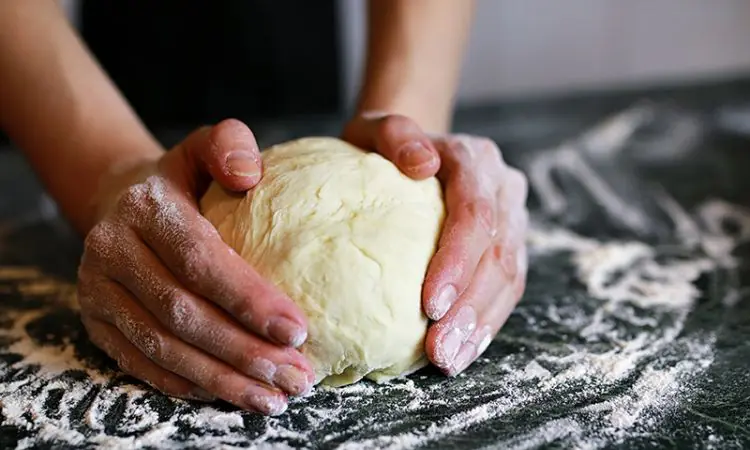Pizza flour, specifically ’00’ flour, has a higher protein content than regular all-purpose flour, yielding a more elastic dough suitable for thin, crispy pizza crusts. Regular flour, while versatile, produces a softer texture ideal for a range of baking needs.
Understanding the difference between pizza flour and regular flour is crucial for achieving the best baking results in your kitchen. Pizza flour, often type ’00’, is finely ground and possesses a gluten level perfect for the stretchy, chewy texture that pizza lovers crave.
The high protein content supports the formation of a strong gluten network, providing the necessary elasticity for tossing and shaping pizza dough without tearing. On the other hand, regular flour, usually an all-purpose variety, is a go-to ingredient for many bakers due to its moderate protein content, which makes it suitable for everything from cakes to bread. So, depending on whether you’re aiming to impress with a homemade pizza or baking a fluffy batch of muffins, choosing the suitable flour can elevate your culinary creations to the next level.

Credit: www.amazon.com
Pizza Flour Vs. Regular Flour: The Essentials
Welcome to the delicious world of pizzas and breads! Today, let’s knead our way into understanding the crucial differences between pizza flour and regular flour. Pizza lovers and avid bakers, it’s time to unravel the secrets behind that perfect crust!
Protein Content: Key To Dough Elasticity
The protein content in flour is like a magic ingredient. It turns your dough from good to great. More protein means more gluten and more gluten means a chewier pizza crust. Pizza flour, often labeled as “bread flour,” boasts a higher protein content of around 12-14%. This gives the dough its stretchy and elastic texture. Regular flour, also called “all-purpose flour,” typically has 8-11% protein. It’s more flexible, making it perfect for cookies and cakes but less for pizzas.
| Flour Type | Protein Content | Best For |
| Pizza Flour | 12-14% | Pizza Dough |
| Regular Flour | 8-11% | Cookies, Cakes |
Origin And Milling Process: A Textural Divide
Where the flour comes from and how it’s made also matter. Pizza flour is often milled from hard wheat. It gives the flour a robust gluten network. Regular flour can come from a mix of both hard and soft wheat, leading to a finer texture with less gluten formation.
- Pizza flour creates a chewy and airy crust.
- Regular flour results in a softer and tender crumb.
The milling process can vary, too. For an ultra-fine consistency, some flours undergo an extra step called ‘double milling.’ This makes them perfect for delicate pastries. Pizza flour is less finely milled to retain its structure-building proteins.
The Role Of Gluten In Pizza Dough Performance
Gluten, a blend of proteins found in wheat flour, is the backbone of pizza dough. It offers the necessary traits that define a perfect crust. Understanding gluten is crucial to mastering the art of pizza-making. The choice between pizza-specific flour and regular flour becomes clear when focusing on gluten’s role.
Gluten’s Impact On Elasticity And Extensibility
Gluten affects how dough behaves. It needs to stretch without tearing. Elasticity is this snap-back quality. Extensibility is its ability to extend without breaking. Both traits are vital for shaping pizza crusts.
- Elastic dough springs back when stretched.
- Extensible dough allows for a thin base that holds its shape.
Different flours offer varying levels of these properties. Pizza flour, rich in gluten, provides a balance of both. It stretches well and maintains the desired shape.
Why High-protein Flour Reigns Supreme In Pizza Making
Protein content in flour directly impacts gluten formation. High-protein or pizza flour typically contains 12-14% protein, leading to more gluten development. This results in a dough that is easier to work with and bakes into a chewy, crisp crust.
| Flour Type | Protein Content | Gluten Quality |
| Pizza Flour | 12-14% | High |
| Regular Flour | 8-11% | Medium |
With pizza flour, the crust becomes airy with a professional texture. It’s why pizza enthusiasts and experts prefer it. Regular flour often needs to improve in both elasticity and extensibility, leading to a less optimal pizza experience.
Culinary Alchemy: Transforming Flour Into Perfect Pizza Bases
The magic of making a perfect pizza base lies in the choice of flour. Different types of flour have unique proportions of protein, which is crucial for the dough’s final texture. Pizza flour, often referred to as ’00’ flour, has a higher protein content than regular all-purpose flour. This difference is what allows pizza chefs to create a base that’s both chewy and airy, translating into that authentic pizzeria texture we all love.
Hydration Ratios And Dough Handling
Hydration ratios, the balance of water to flour, are pivotal in dough performance. The proper ratio affects the dough’s elasticity and fermentation. Adequately hydrated pizza dough can stretch without tearing, ensuring a uniform base. Regular flour with a lower protein content can handle less water, leading to a stricter dough that’s harder to shape.
Pizza flour excels with a hydration ratio typically between 55% to 65%. This range is critical to a dough that transforms smoothly into that signature pizza base. In contrast, regular flour might require adjustments to water levels, resulting in less predictable outcomes.
The Fermentation Effect: Taste And Texture
Yeast-driven fermentation is the unsung hero behind the deep flavors in a pizza crust. High-protein pizza flour undergoes longer fermentation without breaking down, a process that creates nuanced tastes and appealing texture.
Fermentation not only produces rise and air pockets but also adds distinctive tangy notes to the dough. While regular flour can ferment, the end product might lack the same depth of flavor and chewiness inherent to a great pizza base.
In summary, the type of flour chosen directly influences every step of pizza dough making, constructing the remarkable transformation from raw ingredients to an exquisite pizza foundation.

Regular Flour’s Versatility In The Kitchen
Exploring the world of flour can feel like a culinary adventure.
Regular flour, often known as all-purpose flour, is a true kitchen chameleon.
It works magic in a vast array of recipes beyond that perfect pizza crust.
Baked Goods Beyond Pizza
Think of regular flour as your go-to for baking.
It creates moist cakes, chewy cookies, and tender muffins.
Imagine the smell of fresh bread or pastries coming right from your oven.
- Soft bread: Gives structure while keeping it light.
- Cookies: Makes them thick and chewy.
- Cakes: Ensures a fine crumb texture.
- Pastries: Produces flaky layers.
Adjusting Recipes For Different Flour Types
Using different types of flour can change a dish’s character.
Swap in bread flour for a chewier pizza base or cake flour for a lighter sponge.
It’s all about the protein content.
| Flour Types and Protein Content | |
| Type of Flour | Protein Content |
| All-Purpose Flour | 10-12% |
| Bread Flour | 12-14% |
| Cake Flour | 7-9% |
To make the swap, consider the flour’s protein content.
Adjust liquids in the recipe if the flour absorbs more or less moisture.
Making The Choice: Selecting The Right Flour For Your Pizza
When creating pizza, flour is the foundation. Not all flours are the same. Each brings a unique texture and flavor to your crust. Understand the differences before choosing your flour. The right choice can lift your pizza from good to great.
Understanding Protein Variations Across Brands
Protein levels in flour affect dough strength and elasticity.</strong> Higher protein means a chewier crust, while lower offers tenderness. Brands matter here. Each brand’s “all-purpose” or “bread” flour has a different protein content. You must check the label. Look for protein around <strong>12-14% for pizza flour. This level usually makes the best crust.
Experimenting With Blending Flour
Do not fear mixing flours. The aim is the perfect pizza base. Start with a base flour. Raw blends can bring in texture or taste nuances. Try combining all-purpose with bread flour. Add a bit of whole wheat for a hearty bite. Remember, every blend will alter the final product. Test and taste for the ultimate mix. Keep notes of ratios to replicate success.
Here is an example blend to get you started:
Flour TypePercentage
| All-purpose | 50% |
| Bread | 30% |
| Whole wheat | 20% |

Credit: www.amazon.com
Home Chefs’ Hack: Elevating Your Pizza With The Right Flour
Making pizza at home is exciting. It can taste just like pizzeria-style. The secret? Flour. Not all flour is the same for pizza. This post shows how to pick and use suitable flour for pizza. Let’s get that perfect crust.
Tips For Achieving Pizzeria-quality Crust
- Type of flour: Use ’00’ flour or high-gluten flour for pizza. This gives a chewy crust.
- Hydration matters: Aim for a 60-70% water-to-flour ratio. This helps your dough stretch and not tear.
- Kneading: Knead dough for at least 10 minutes. This develops gluten for a better texture.
- Thickness: Roll or press your dough thin. Aim for about 1/4 inch thickness for an even bake.
The Proof Is In The Proofing: Time And Temperature Tricks
- Cold ferment: Let dough rest in the fridge for 24-72 hours. This deepens flavor and texture.
- Room temperature rise: Before baking, let the dough sit at room temperature for 1-2 hours. This relaxes the gluten for better shaping.
- Consistent heat: Preheat your oven as hot as possible. Use a pizza stone or steel for even cooking.
- Control humidity: A humid oven helps the crust rise. Place a pan of water in the oven if needed.
Frequently Asked Questions On What Is The Difference Between Pizza Flour And Regular Flour
Can Pizza Flour Be Used As Regular Flour?
Pizza flour, designated explicitly as ’00’ flour, has a finer grind and higher protein content than regular all-purpose flour. It can be used interchangeably in recipes but may result in a different texture.
What Makes Pizza Flour Distinct From All-Purpose?
Pizza flour, often ’00’ grade, is milled to an ultra-fine consistency. It boasts a higher protein content, creating a more elastic dough suitable for thinner, crispier pizza crusts compared to all-purpose flour.
Is Bread Flour And Pizza Flour The Same?
Bread flour and pizza flour have similarities, such as high protein content, yet they differ. Bread flour yields a denser, chewier bread texture, while pizza flour is refined for a tender, blistered pizza crust.
How Does Regular Flour Affect Pizza Dough Quality?
Using regular all-purpose flour for pizza dough typically results in a crust that’s less chewy and lacks the signature airy pockets found in pizza made with specialized pizza flour.
Conclusion
Understanding the nuances between pizza flour and regular flour is essential for perfecting your baking creations. Pizza flour’s higher protein content is vital for chewy, robust crusts, while regular flour suits a variety of everyday recipes. Choose wisely to elevate your culinary adventures and impress with each bite.

As the author of the “Ultimate Pizza Guide: Recipes, Tips & Secrets Revealed,” I’m dedicated to sharing my love for pizza and empowering others to create delicious homemade pizzas with ease. Join me on a journey to uncover the secrets to perfecting your pizza game!



